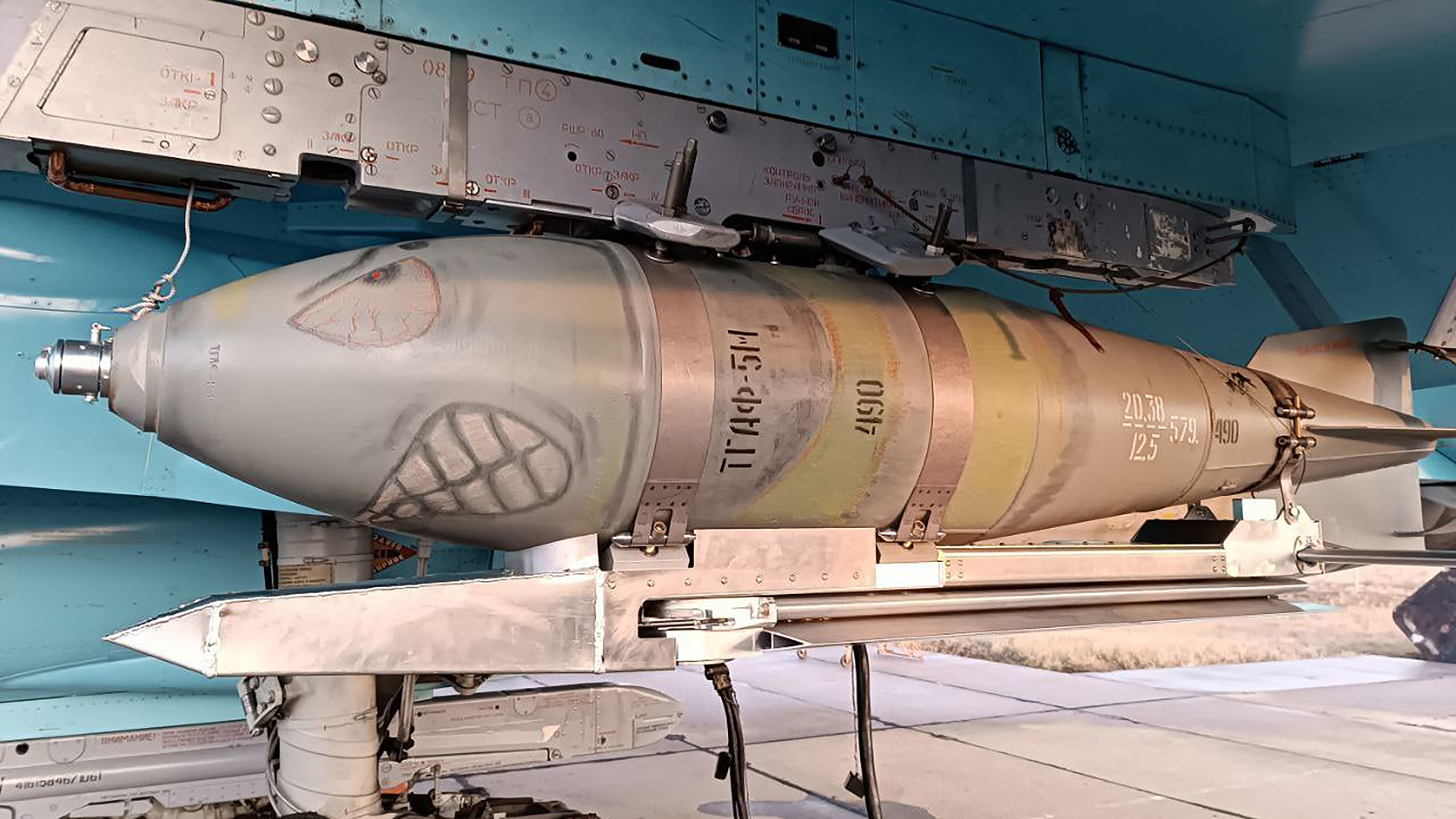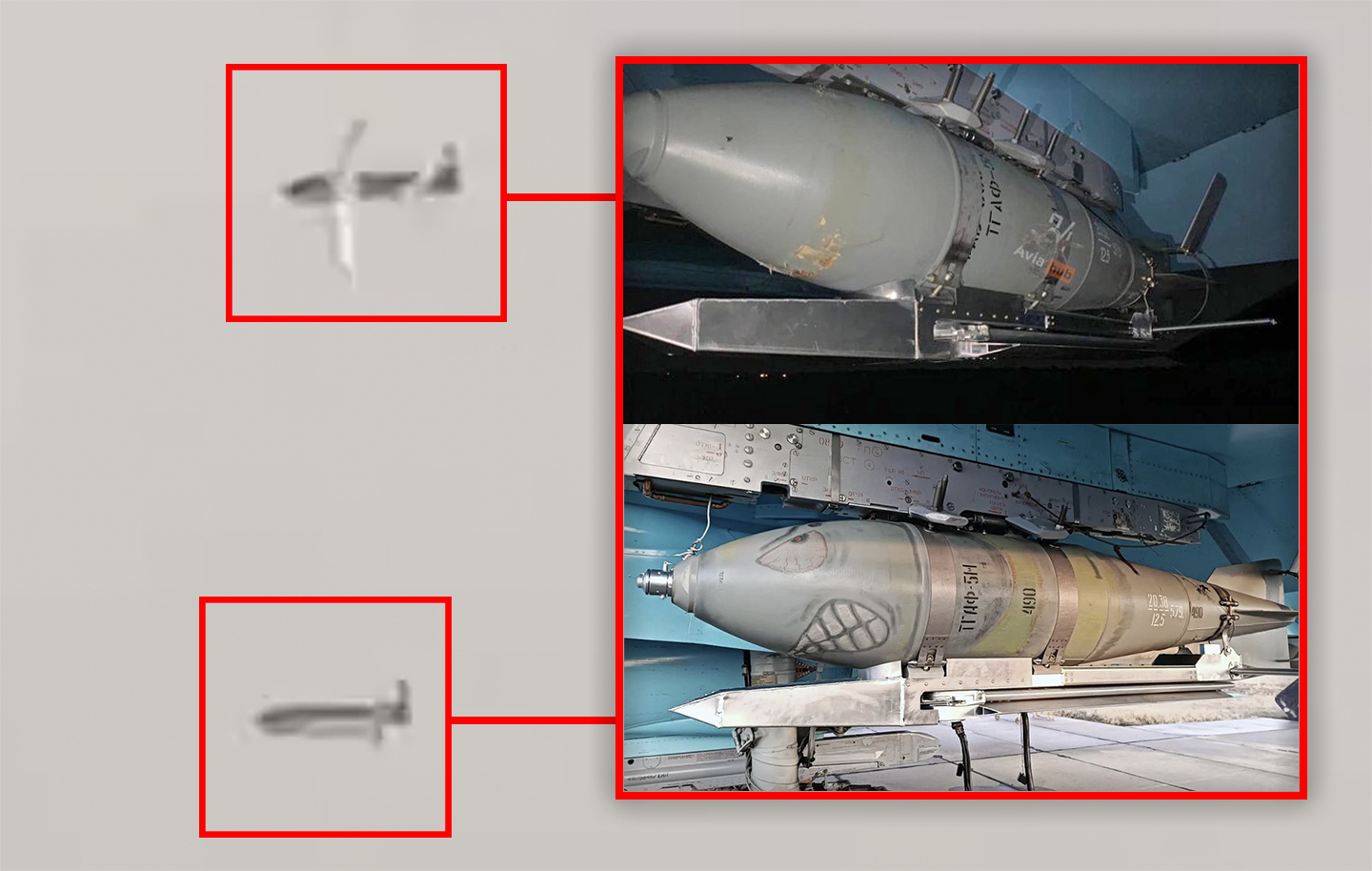A recent video provides, apparently for the first time, a view of a Russian tactical fighter launching glide bombs fitted with range-extending wing kits. These wing kits first came to light earlier this year but have so far only been seen on a few occasions, either attached to aircraft or in the form of scattered wreckage. In the meantime, these weapons, which allow pilots to stay further away from potential threats, have been highlighted by Ukrainian officials as a significant headache for the country’s air defenses.
The video in question, which is posted above, appeared on the pro-Russian Fighterbomber channel on the Telegram social media network. Only around five seconds long, it shows a pair of wing-kit glide bombs soon after launch, including the wings swinging forward in deployed position. The video is taken from the cockpit of a Russian tactical jet, apparently a Su-34 Fullback, although it’s not immediately clear if the weapons were launched by this aircraft or a wingman.
Unconfirmed reports suggest that the weapons are the same type of FAB-500M-62 bombs with wing kits attached that began to appear earlier this year. At this point, it’s still unclear if this particular ad-hoc adaptation has any kind of onboard guidance system, and to what degree if so, or if it simply relies on its pop-out wings to deliver less accurate strikes at standoff ranges. Under such a concept, they would be used primarily against larger area targets, such as Ukrainian cities.
Claims have been made by both Russian and Ukrainian sources as to how these weapons work, with Ukrainian officials suggesting that some kind of GPS guidance is involved, but so far there are very few concrete details available of the nature of the guidance.
In the past, we looked at the possibility that the first iteration of the Russian glide bombs that we saw might have some kind of very basic guidance, perhaps with rear stabilizers that can be articulated for limited course correction. Again, this remains speculative, and the existence of a guidance system remains uncertain for now.
Even just some kind of limited wind correction guidance would offer a much better alternative than none at all.
The reported designation for the weapons is Universalnaya Modul Planirovaniya i Korrektsi (UMPK), or “universal gliding and correction module.”

As we have seen in the past, the wing kit appears to consist of two pop-out main wings and a pair of horizontal stabilizers fitted to an elongated metal assembly that is strapped to FAB-500M-62. This is a 1,100-pound (500-kilogram) class general-purpose high-explosive bomb, although it’s very likely that other types of freefall ‘dumb’ bombs have also been adapted in the same way.
The construction of these wing kits appears very basic, at least when they first appeared, although there could have been efforts to refine its design since then. Either way, the overall appearance of this kind of weapon does seem to suggest that it prioritizes rapid, low-cost production, rather than a higher-end weapon of bespoke design. This may also point to Russia’s apparent problems in terms of the availability of purpose-designed standoff precision-guided munitions.
As well as this apparently extemporized glide bomb design, Russia is known to have conducted previous work on range-extending wing kits for unguided, as well as guided bombs. These include the Modul Planirovaniya i Korrektsi (MPK), or “gliding and correction module,” from the Russian GNPP Bazalt company. The MPK has been proposed for various types of dumb bombs, including the FAB-500M-62 and its designation suggests at least some commonality with the UMPK, even if limited to its concept of operations.

In its basic form, the MPK kit has no internal guidance system but is said to have a range of 3.7-4.3 miles when launched from low altitude. While the relationship between this kit and the glide bombs that Russia has been using over Ukraine remains unclear, it’s feasible that these weapons attain a similar kind of range to the MPK, with their reach increasing drastically when launched from higher altitudes.
A more recent photo of a Russian glide bomb kit has been described as a UMPK weapon (the ‘U’ signifying ‘universal’), suggesting at least some similarities, if even in terms of concept, with the earlier MPK.
Regardless, comparisons between Russian glide bombs used in Ukraine and the U.S.-designed Joint Direct Attack Munition (JDAM) appear premature, to say the least. The JDAM series features an inertial navigation system (INS) and GPS guidance, together with an autopilot, with the bomb’s course determined via a set of steerable tail fins.

JDAM can also be fitted with a wing kit, known as JDAM-ER, to hit targets up to 40 miles away and this configuration has been supplied to Ukraine.
And, even without a guidance system of any kind, it seems clear that Russia would have a place for an extended-range bomb in its inventory.
While Ukrainian officials have warned about the threat of winged glide bombs for some months now, recent unconfirmed reports out of Russia suggest that these kinds of weapons could now be playing a more important role in the Kremlin’s air war tactics.
Russian military bloggers have claimed that fixed-wing tactical aircraft are using increasing numbers of standoff weapons, including glide bombs, launched from a greater distance from known Ukrainian ground-based air defense systems (GBADS) positions.
With these kinds of weapons being employed in more significant numbers, Ukraine is forced to move more air defense systems — including medium- and long-range ones — closer to the front lines to attempt to destroy the munitions, if not the aircraft launching them.
This, however, can result in certain vulnerabilities, as once the radars of the Ukrainian air defense systems are activated, Russian forces can geolocate them and target them in turn with Lancets and other loitering munitions and drones, as well as with air-launched anti-radiation missiles.
All of this provides Ukrainian air defense operators with more problems, especially bearing in mind the limited availability of mobile short-range air defense systems (SHORADS) to support Ukrainian armor and other forces at the front. Those same systems that can help defend critical targets against incoming glide munitions are needed to support the counteroffensive, especially as Russian rotary-wing aviation has seen a resurgence along the front.
And, of course, surface-to-air missiles are becoming more precious for Ukraine as their existing stocks of Soviet-era systems runs down. Using these weapons to shoot down crude winged bombs certainly doesn’t make the situation better.
With all this in mind, even an unguided bomb with a wing kit would offer at last some useful additional standoff range for Russian pilots, and at a relatively low cost. This would, in turn, allow them to stay just that much further away from hostile air defenses. The air forces of both Russia and Ukraine have seen significant losses to surface-to-air missiles in what has now been nearly a year of all-out fighting.
Aside from this, Russia clearly has a requirement, more generally, for standoff weapons that can reduce the threat of exposure to Ukrainian ground-based air defenses. To a large degree, the dense air defense environment over much of Ukraine has dictated how Russian tactical aviation operates, including forcing fixed-wing tactical aircraft and helicopter crews to conduct most flight operations at very low levels if they are to venture near the front lines. The same also applies to Ukraine aircraft.
While releasing glide bombs at lower attitudes reduces how far the wing-equipped bombs can travel, lofting or toss-bombing tactics might help. There remains, however, the question of accuracy in the case of glide bombs without guidance systems used against front line targets. Although certain military targets — among them, trench lines, other fortification networks, and areas with large concentrations of enemy forces — could still be options for unguided weapons of this type.
The video above, however, shows what we largely already thought was the case, that Russia is releasing glide weapons from higher altitudes, to give the weapons as much glide range as possible. This should allow Russian tactical aircraft to launch them dozens of miles away from their targets, giving them a degree of survivability that is otherwise only possible by using expensive precision standoff weaponry. With more advanced Western air defense equipment, like the Patriot, now in Ukrainian hands, such concerns only become more urgent on the part of the Russians.
Meanwhile, guidance package or otherwise, we do know that Russia has long been pursuing a campaign of airstrikes that includes civilian targets, among them cities and population centers. In this kind of scenario, the accuracy of standoff weaponry appears to be of lesser concern. Ukrainian officials, too, have brought particular attention to the threat posed by glide bombs to exactly these kinds of objectives.
For the time being, the exact capabilities that the Russian glide-bomb wing kit offers remain unclear, but with multiple reports that the use of these kinds of weapons is only increasing, we are very likely to find out more soon.
Contact the author: thomas@thedrive.com
